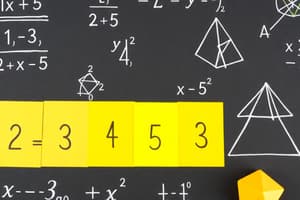Podcast
Questions and Answers
What is the correct order of operations to follow when solving mathematical expressions?
What is the correct order of operations to follow when solving mathematical expressions?
Which of the following forms the basis of the Pythagorean theorem?
Which of the following forms the basis of the Pythagorean theorem?
What does the derivative in calculus represent?
What does the derivative in calculus represent?
Which type of statistics involves making inferences about populations based on sample data?
Which type of statistics involves making inferences about populations based on sample data?
In number theory, what is the significance of prime numbers?
In number theory, what is the significance of prime numbers?
Which of the following concepts in probability refers to the likelihood of a particular outcome occurring?
Which of the following concepts in probability refers to the likelihood of a particular outcome occurring?
What is a Venn diagram used to illustrate in set theory?
What is a Venn diagram used to illustrate in set theory?
Which of the following is NOT a useful strategy for studying mathematics effectively?
Which of the following is NOT a useful strategy for studying mathematics effectively?
Flashcards are hidden until you start studying
Study Notes
Key Areas in Mathematics
-
Arithmetic
- Basic operations: addition, subtraction, multiplication, division.
- Order of operations: PEMDAS (Parentheses, Exponents, Multiplication and Division, Addition and Subtraction).
-
Algebra
- Variables and expressions: Understanding symbols that represent numbers.
- Equations: Solving for unknown values.
- Functions: Relationships between sets, often expressed as f(x).
-
Geometry
- Shapes and properties: Circles, triangles, squares, polygons.
- Theorems: Pythagorean theorem, properties of angles.
- Area and volume calculations: Formulas for different shapes.
-
Trigonometry
- Ratios: Sine, cosine, tangent and their applications to right triangles.
- Unit circle: Understanding angles and coordinates.
- Trigonometric identities: Formulas like sin²x + cos²x = 1.
-
Calculus
- Limits: The foundational concept of calculus.
- Derivatives: Rate of change and slope of curves.
- Integrals: Area under curves and accumulation of quantities.
-
Statistics
- Data collection: Surveys, experiments.
- Descriptive statistics: Mean, median, mode, range.
- Inferential statistics: Hypothesis testing, confidence intervals.
-
Probability
- Basic concepts: Outcomes, events, sample space.
- Rules: Addition and multiplication rules.
- Distributions: Normal distribution, binomial distribution.
-
Number Theory
- Prime numbers: Definition and significance.
- Divisibility rules: Understanding factors and multiples.
- Modular arithmetic: Remainders and congruences.
-
Set Theory
- Sets and subsets: Collections of objects.
- Union and intersection: Combining and finding common elements.
- Venn diagrams: Visual representation of sets.
-
Mathematical Reasoning
- Logic: Statements, truth values, and logical operations.
- Proofs: Direct, indirect, and contradiction methods.
- Problem-solving strategies: Identifying the problem, developing a plan, carrying out the plan, and reviewing.
Practical Applications of Mathematics
- Finance: Budgeting, interest calculations, investments.
- Engineering: Structural calculations, design principles.
- Data Analysis: Interpreting and visualizing data trends.
- Computer Science: Algorithms, cryptography, programming logic.
Study Tips
- Practice regularly with exercises and problems.
- Use visual aids like graphs and diagrams.
- Relate concepts to real-world applications for better understanding.
- Collaborate with peers for group studies and discussions.
Key Areas in Mathematics
-
Arithmetic involves basic operations such as addition, subtraction, multiplication, and division.
-
The order of operations is crucial, represented by the acronym PEMDAS (Parentheses, Exponents, Multiplication and Division, Addition and Subtraction).
-
Algebra focuses on variables and expressions, allowing the representation of unknown values through symbols.
-
Equations are crucial for solving for unknowns, while functions express relationships between sets, often denoted as f(x).
-
Geometry studies shapes and their properties, including circles, triangles, squares, and polygons.
-
Important theorems like the Pythagorean theorem and angle properties guide calculations of area and volume using specific formulas applicable to various shapes.
-
Trigonometry deals with the ratios of sides in right triangles, specifically sine, cosine, and tangent.
-
Understanding the unit circle is key for grasping angles and coordinates, complemented by trigonometric identities such as sin²x + cos²x = 1.
-
Calculus introduces the concept of limits, fundamental to further calculus studies.
-
Derivatives measure the rate of change and slope of curves, while integrals calculate the area under curves indicative of quantity accumulation.
-
In Statistics, data collection involves methods like surveys and experiments.
-
Descriptive statistics summarize data with measures such as mean, median, mode, and range, while inferential statistics explores hypothesis testing and confidence intervals.
-
Probability covers basic concepts like outcomes, events, and sample spaces, essential for understanding randomness.
-
The addition and multiplication rules help calculate probabilities, alongside distributions such as the normal and binomial distributions.
-
Number Theory investigates prime numbers, including their definitions and significance.
-
Divisibility rules clarify factors and multiples, while modular arithmetic focuses on remainders and congruences.
-
Set Theory defines sets and subsets as collections of objects, facilitating operations like union and intersection to combine sets or find common elements.
-
Venn diagrams visually represent these concepts for better comprehension.
-
Mathematical Reasoning emphasizes logic, including statements and truth values.
-
Various proof methods (direct, indirect, contradiction) are crucial for validating mathematical assertions, along with problem-solving strategies that include identifying problems, planning, executing, and reviewing solutions.
Practical Applications of Mathematics
- Finance extends mathematics through budgeting, interest calculations, and investment strategies.
- Engineering applies mathematical principles for structural calculations and design developments.
- Data Analysis utilizes mathematical techniques for interpreting and visualizing trends in data.
- Computer Science employs mathematics in algorithms, cryptography, and programming logic.
Study Tips
- Regular practice with exercises and problems enhances comprehension and retention.
- Utilizing visual aids such as graphs and diagrams can aid in understanding complex concepts.
- Relating mathematical concepts to real-world applications fosters a deeper understanding.
- Collaboration with peers during group studies encourages discussions that can clarify topics and enhance learning.
Studying That Suits You
Use AI to generate personalized quizzes and flashcards to suit your learning preferences.




